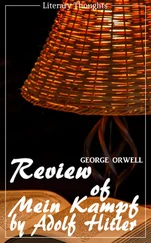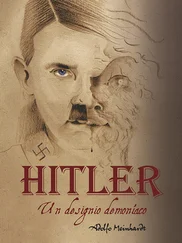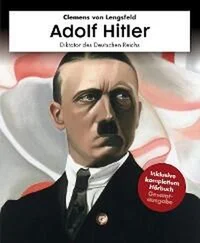Christa Schroeder - He Was My Chief - The Memoirs of Adolf Hitler's Secretary
Здесь есть возможность читать онлайн «Christa Schroeder - He Was My Chief - The Memoirs of Adolf Hitler's Secretary» весь текст электронной книги совершенно бесплатно (целиком полную версию без сокращений). В некоторых случаях можно слушать аудио, скачать через торрент в формате fb2 и присутствует краткое содержание. Город: Barnsley, Год выпуска: 2012, ISBN: 2012, Издательство: Frontline Books, Жанр: История, Биографии и Мемуары, на английском языке. Описание произведения, (предисловие) а так же отзывы посетителей доступны на портале библиотеки ЛибКат.
- Название:He Was My Chief: The Memoirs of Adolf Hitler's Secretary
- Автор:
- Издательство:Frontline Books
- Жанр:
- Год:2012
- Город:Barnsley
- ISBN:978-1-7830-3064-4
- Рейтинг книги:4 / 5. Голосов: 1
-
Избранное:Добавить в избранное
- Отзывы:
-
Ваша оценка:
- 80
- 1
- 2
- 3
- 4
- 5
He Was My Chief: The Memoirs of Adolf Hitler's Secretary: краткое содержание, описание и аннотация
Предлагаем к чтению аннотацию, описание, краткое содержание или предисловие (зависит от того, что написал сам автор книги «He Was My Chief: The Memoirs of Adolf Hitler's Secretary»). Если вы не нашли необходимую информацию о книге — напишите в комментариях, мы постараемся отыскать её.
He Was My Chief: The Memoirs of Adolf Hitler's Secretary — читать онлайн бесплатно полную книгу (весь текст) целиком
Ниже представлен текст книги, разбитый по страницам. Система сохранения места последней прочитанной страницы, позволяет с удобством читать онлайн бесплатно книгу «He Was My Chief: The Memoirs of Adolf Hitler's Secretary», без необходимости каждый раз заново искать на чём Вы остановились. Поставьте закладку, и сможете в любой момент перейти на страницу, на которой закончили чтение.
Интервал:
Закладка:
Chapter 13
Obersalzberg
IN 1877 MAURITIA ‘MORITZ’ Mayer bought the equestrian establishment and Steinhaus estate together with all the summer pasture around the Kehlstein mountain. She turned the Steinhaus into the first hotel on the Obersalzberg. Under her proprietorship ‘Pension Moritz’ became a much-visited resort for guests and convalescents. Rich people from the city arrived as a result, buying up old farms or building their own mountain retreats. Professor Karl von Linde for example purchased the so-called Baumgarten estate and laid a road, later called the Professor von Linde Weg, to the Hochlenzer. [115] The Hochlenzer, built in 1672, was an old settlement on the salt road from Hallein to Augsburg which crossed the Obersalzberg. (TN)
The Berlin piano manufacturer Bechstein built a house there, and Dr Seitz, a paediatrician, set up a sanatorium for children. A Buxtehude businessman, Herr Winter, had an all-weather alpine chalet built there.
In the 1920s Adolf Hitler and senior NSDAP men Hermann Esser and Christian Weber came often to the Obersalzberg because the hunted NSDAP fugitive Dietrich Eckart, Hitler’s mentor, had found shelter there. It was through Christian Weber, who found lodgings for Eckart at the Brückner house, that Hitler came to the Obersalzberg for the first time. He was fascinated by the scenery. Hitler told us the story at tea one day. One can read all about it in Heim’s Monologe im Führerhauptquartier , [116] Table-talk of 16 January 1942, Orbis edition 2000, pp. 202–5. (TN)
since a stenographic note was kept. Dietrich Eckart introduced Hitler to many of the local inhabitants including Frau Bechstein, with whose help he rented Haus Wachenfeld from Frau Winter of Buxtehude for 100 RM. The tenancy was put into the name of his half-sister Angela Raubal at first, and in 1927 he transferred it to his own name before eventually purchasing the house outright from the executors of Frau Winter’s estate in 1934.
In August 1933 I was summoned by telephone to Obersalzberg [117] Obersalzberg overlooks Berchtesgaden from the northern foot of the Hoher Göll. The mountain was owned by the NSDAP and was never the seat of government. The terrain of about 1,000 hectares was 278 hectares farmland and 716 hectares woods and mountainside. Seider and Zeigert, Die Führerhauptquartiere , Herbig, pp. 259, 265. (TN)
unexpectedly. At the time I was working with the Liaison Staff. I arrived at Haus Wachenfeld in the afternoon to be welcomed by Frau Raubal. She was a widow six years older than her half-brother. She had had three children by her marriage to a taxation official: Friedl and Geli, and a son, Leo, who taught in Linz. Frau Raubal ran the household for Hitler. She was capable, active and a person who maintained discipline, often hitting the table with her fist impulsively at mealtimes to make a point. She was a figure who inspired respect. She controlled her staff with a rod of iron and also felt responsible for ensuring the well-being of her half-brother, although he did not seem to want this particularly.
In an obviously distressed state she told me that Hitler had gone off on a car trip with the gentlemen of his staff and some ladies, and were overdue. Greatly worried that some accident had befallen them, she was apparently glad to see me as it would help to take her mind off the matter. She volunteered to show me the ground-floor rooms of the Bavarian shingle-roofed house. A wooden balcony decorated with bright geraniums encircled the structure. The living room was typically Bavarian. A green dresser with farming scenes, a commode and rustic chairs, a grandfather clock and, on a corner table, statuettes of a farmer with canary and a Moorish dancer. Not very Bavarian on the other hand were the many cushions and rugs embroidered with the swastika and mountain blooms in all colours which lay everywhere in abundance, all presents from Hitler’s female admirers. Frau Raubal had apparently not had the heart to throw out all this evidence of the love and affection which these handicrafts manifested, and only after the conversion work to the house and the departure of Frau Raubal in 1936 did they disappear.
She took me to the glass veranda annexed to the employee’s rooms. It was built by Munich architect Neumayer together with the garage and terrace in April 1933. Meals were taken in the glass veranda, she told me. During my stay I was able to confirm what a careful housekeeper and outstanding cook Frau Raubal was. A real delicacy were the little apple pies she made, which were something new for me. Then she led me to the terrace and showed me the view over Berchtesgaden which stretched out below in the valley to the north. To the right of it was the Salzburg region. Opposite the house was the very impressive sight of the Watzmann (2,715 metres) and Untersberg (today Ettenberg, this latter mountain being the seat of legend, the place where Barbarossa is said to be entombed awaiting the day of his return, rather like King Arthur), the Hohe Göll and the Steinernes Meer. Well-maintained paths led from the terrace to the lawn at the side of the house: there used to be a rock garden on the southern slope with a number of paths crisscrossing it.
At the foot of the northern rock wall was a weathered, elongated, low, wooden annexe fronted by a wooden gallery decorated with a mass of red geraniums. The balustrade had supporting columns to the roof. It formed an enchanting, living contrast to the brooding, gloomy mountains to the south of the house. This single-storey structure adjoining Haus Wachenfeld had five rooms: a simple office, three guest rooms and a large dormitory for the SS-Begleitkommando . Later two of the guest rooms were converted into a medical surgery and the surgery of Dr Blaschke, Hitler’s dentist. In the summer of 1933 all guests booked into the nearby pensions on the Obersalzberg. At the end of the elongated annexe was the so-called ‘adjutants’ shack’. A narrow wooden stairway on the outside at the front led up to two small rooms: a bedroom with bath and an office for the duty adjutant. A telephone switchboard was located on the ground floor.
At sunset that day Frau Raubal and I stood on the terrace overlooking the road leading upwards, awaiting the return of the overdue excursionists. I could hear one of the maids, dressed in Tyrolean costume, setting the table for dinner in the glass veranda. Finally some cars came up the mountain, the small house filled with the voices of the arrivals and a short time later Hitler’s guests assembled in the veranda. Hitler and Frau Raubal occupied the table ends while the guests sat where they fancied. On that occasion I remember Hitler’s photographer Heinrich Hoffmann with his wife Erna, Hitler’s long term chauffeur SS-Staffelführer Julius Schreck and female friend, Reich press chief Dr Otto Dietrich with his wife, Julius Schaub, Eva Braun and Anni Rehborn.
Of the last, ‘Rehlein’, I would like to say something. In 1923 and 1924 she won the German swimming championships in the hundred-metres crawl and backstroke. When the Berliner Illustrierte published her photograph on the title page◦– it was seen by Hitler’s followers sharing his imprisonment at Landsberg◦– Hitler’s chauffeur Emil Maurice was inspired to send Anni Rehborn his congratulations. After their release a meeting took place at which Hitler was present, and at Christmas 1925 he sent her a copy of Mein Kampf bound in red leather with the inscription ‘To Fräulein Anni Rehborn in sincere admiration’, and encouraged her to visit whenever she was in Bavaria. She took him up on this offer frequently. In July 1933 while touring Germany in her small red DIXI car with her fiancé Dr Karl Brandt, Hitler invited them both to stay for a few days on the Berg, where they were booked into one of the pensions as his guests, and came up to Haus Wachenfeld for lunch and dinner.
Читать дальшеИнтервал:
Закладка:
Похожие книги на «He Was My Chief: The Memoirs of Adolf Hitler's Secretary»
Представляем Вашему вниманию похожие книги на «He Was My Chief: The Memoirs of Adolf Hitler's Secretary» списком для выбора. Мы отобрали схожую по названию и смыслу литературу в надежде предоставить читателям больше вариантов отыскать новые, интересные, ещё непрочитанные произведения.
Обсуждение, отзывы о книге «He Was My Chief: The Memoirs of Adolf Hitler's Secretary» и просто собственные мнения читателей. Оставьте ваши комментарии, напишите, что Вы думаете о произведении, его смысле или главных героях. Укажите что конкретно понравилось, а что нет, и почему Вы так считаете.












